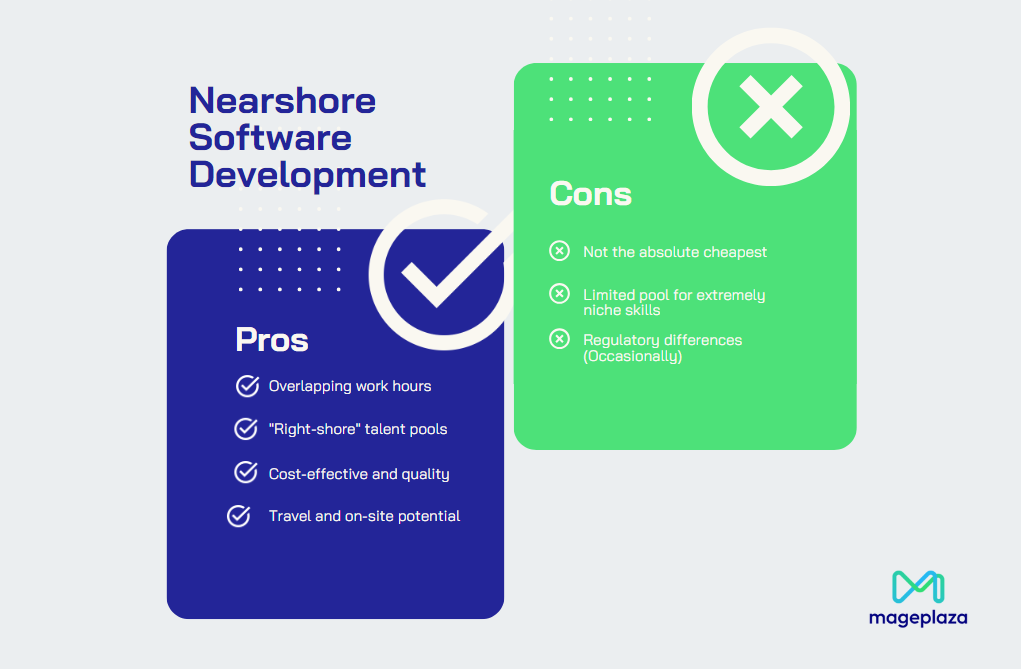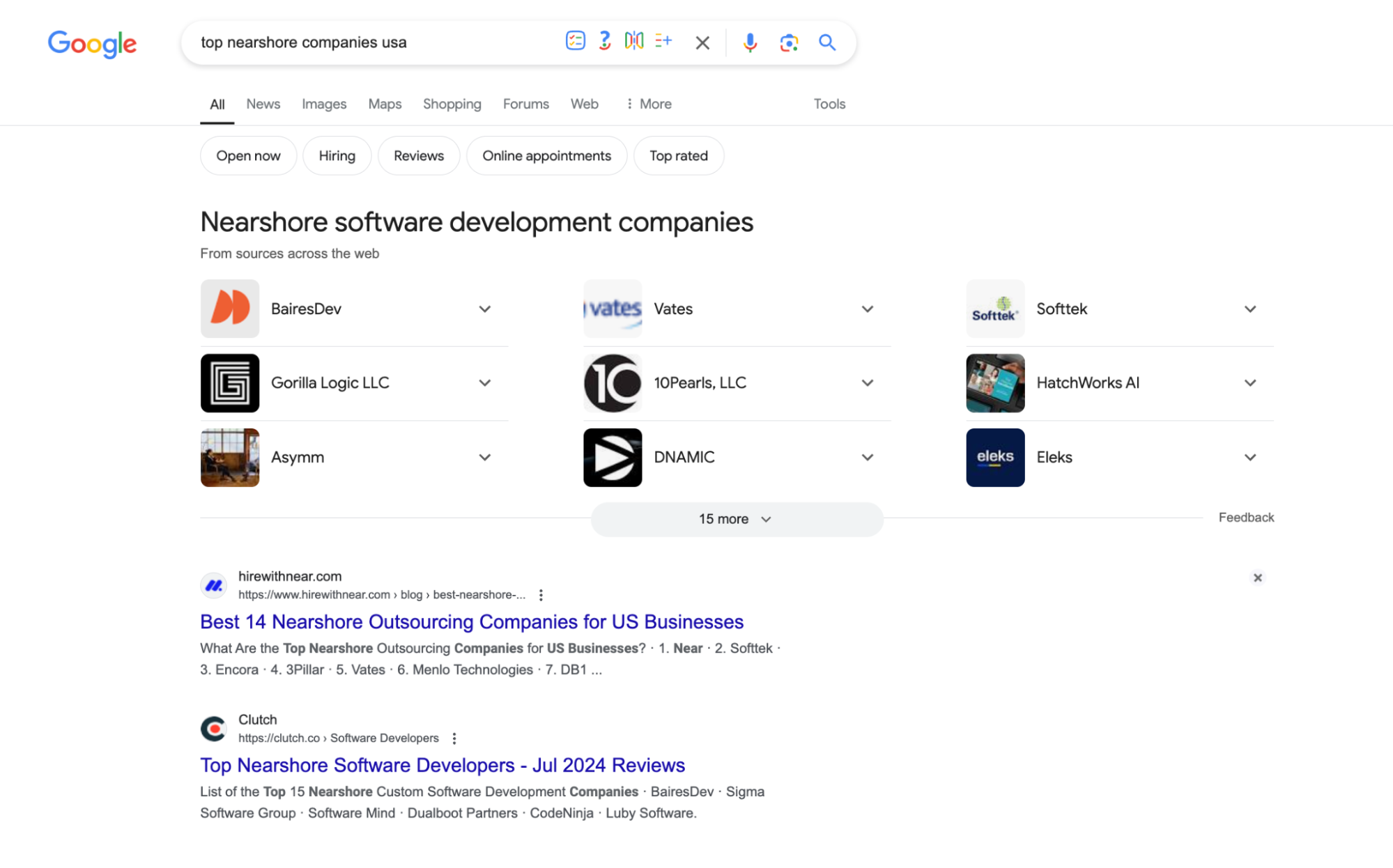The Premier Guide to Nearshore Software Development 2024
Summer Nguyen | 08-05-2024
You’re leading a critical software project, but your in-house team is stretched thin. Deadlines loom, costs escalate, and the pressure is mounting. Sound familiar? This is the reality many businesses face, but there’s a solution that’s closer than you think. Nearshore software development offers a lifeline, providing access to skilled talent in neighboring countries, often within similar time zones and cultural contexts.
In this guide, we’ll delve into the world of nearshore, sharing real-world examples and actionable tips to help you build a high-performing nearshore team that delivers results.
What is Nearshore Software Development?

Nearshore software development is a strategic outsourcing model where companies delegate software development tasks or projects to teams located in neighboring or nearby countries. These teams operate within similar time zones, often sharing cultural similarities and overlapping business hours with the hiring company. This proximity fosters smoother communication, easier collaboration, and better project management compared to traditional offshore outsourcing.
The nearshore software development market is experiencing considerable growth in 2024, driven by several main factors. Companies are increasingly seeking cost-effective alternatives to traditional outsourcing models, and nearshore providers offer a compelling solution. With a projected growth rate of 20% in 2024, nearshore development is rapidly gaining traction across various industries.
Specific data highlights the growing adoption of nearshore development. According to a recent study by HatchWorks, 59% of companies choose nearshore software development as a cost-cutting tool
How Nearshore Differs from Offshore Outsourcing and Onshore
Nearshore, offshore, and onshore outsourcing represent distinct approaches to delegating software development tasks, each with its own advantages and considerations:
- Nearshore outsourcing: As we mentioned above, this model involves partnering with teams in neighboring or nearby countries. This offers a balance between cost-effectiveness and proximity. Shared time zones and cultural similarities facilitate communication and collaboration, while lower labor costs compared to onshore options make it attractive.
- Offshore outsourcing: This entails collaborating with teams located in distant countries, often on different continents. This approach typically offers the lowest labor costs, but challenges like time zone differences, cultural barriers, and potential communication difficulties can arise.
- Onshore outsourcing: Refers to delegating tasks to teams within the same country. This provides the closest proximity and shared cultural context, leading to seamless communication and collaboration. However, it tends to be the most expensive option due to higher labor costs.
We’ve developed a comparison table to help you clearly see the differences between these three outsourcing models:
| Feature | Nearshore | Offshore | Onshore |
| Location | Neighboring countries | Distant countries | Same country |
| Cost | Moderate | Low | High |
| Time Zone | Similar/overlapping | Different | Same |
| Communication | Relatively easy | Can be challenging | Easiest |
| Cultural Fit | Relatively close | Can be different | Same |
| Travel | Possible | Difficult | Easy |
| Control | Moderate | Moderate | High |
Related topic: Offshoring Vs. Outsourcing: Meanings, Benefits & Comparison
Pros and Cons of Hiring Nearshore Software Development
Like any outsourcing model, nearshore software development has advantages and challenges that companies must consider before embarking on such partnerships.

Advantages
The key advantages of nearshore development include:
- Overlapping work hours: Nearshore isn’t just about geographical proximity; it’s about finding the sweet spot between cost-effectiveness and quality. Overlapping work hours, often more extensive than even some onshore teams, enable real-time collaboration and faster issue resolution. This is particularly beneficial for Agile development, where quick iterations and constant communication are key.
- “Right-shore” talent pools: Nearshore development also taps into “right-shore” talent pools. Specific regions excel in certain technologies, like Eastern Europe for .NET or Latin America for mobile development. This specialization gives you access to niche expertise that might be harder to find onshore.
- Cost-effective and quality: While not the absolute cheapest option, nearshore offers a compelling balance of cost and quality. You gain access to experienced developers who charge less than top onshore talent, but with quality often exceeding some offshore providers due to stricter education and industry standards in certain regions.
- Travel and on-site potential: Additionally, travel and on-site potential are more feasible with nearshore teams. Should in-person interaction be necessary, shorter travel times and minimal time zone adjustments make collaboration easier.
Challenges
While nearshore offers numerous benefits, it’s important to consider potential drawbacks:
- Not the absolute cheapest: If budget is the only factor, some offshore options might undercut nearshore rates. However, the potential for rework, miscommunication, and lower quality often negates those savings.
- Limited pool for extremely niche skills: While nearshore offers specialization, finding the absolute cutting edge of a very niche technology might be easier in a global talent pool. This is rare but worth considering for highly experimental projects.
- Regulatory differences (Occasionally): Depending on your industry and the nearshore location, data protection or intellectual property laws might differ slightly. Due diligence is needed to ensure compliance on both ends.
Popular Nearshore Destinations
Where can you find the perfect nearshore partner? Let’s explore some popular destinations worldwide, each offering unique advantages.
Latin America

Highlighted below are some prominent Latin American countries for nearshore software development:
- Mexico: A long-standing favorite for North American companies, Mexico’s appeal lies in its proximity, cultural alignment, and burgeoning tech scene. Guadalajara and Monterrey, two major tech hubs, boast thriving IT ecosystems and a wealth of skilled developers. The Mexican government actively supports the tech sector, offering incentives and fostering a conducive environment for innovation. Pricing ranges from $25 to $50 per hour, Mexico strikes a balance between affordability and quality..
- Costa Rica: Known for its political stability, emphasis on education, and commitment to sustainable development, Costa Rica provides a reliable and secure environment for nearshoring. The country’s high English proficiency levels, growing tech talent pool, and focus on innovation make it an attractive option for companies seeking long-term partnerships. Hourly rates in Costa Rica typically range from $30 to $60.
- Colombia: Colombia’s tech scene is rapidly expanding, fueled by government initiatives, a young and eager workforce, and a growing number of tech hubs. The country’s diverse talent pool, competitive labor costs, and improving infrastructure have positioned it as an emerging powerhouse for nearshoring. Colombian developers typically command hourly rates between $20 and $45.
Eastern Europe
The following Eastern European countries are exemplary in nearshore software development:
- Poland: With a mature tech industry, a highly educated workforce, and a strong focus on research and development (R&D), Poland stands out as a prime nearshore destination. Its EU membership, well-developed infrastructure, and cultural affinity with Western Europe make it an ideal choice for European companies. Polish developers typically charge between $30 and $60 per hour.
- Portugal: Strategically located on the Iberian Peninsula, Portugal offers a stable political environment, a growing tech scene, and a multilingual workforce. The country’s competitive costs, government support for innovation, and attractive lifestyle make it an interesting choice for nearshore development. Hourly rates in Portugal typically range from $25 to $55.
Asia
This region is a rising star for cost-effective and efficient development, especially in the following countries:
- India: Although traditionally considered an offshore destination, India has emerged as a viable nearshore option for certain regions, particularly those in Europe and the Middle East. With a wealth of tech talent, competitive wages, and growing English proficiency, it stands out as a prime choice for companies looking for a cost-effective and efficient nearshore solution. Additionally, India’s time zone overlaps with some European countries allowing for real-time collaboration and faster project turnaround times. Hourly rates for Indian developers typically range from $18 to $50.
- Vietnam: Vietnam’s tech industry is experiencing rapid growth, driven by a young and motivated workforce, government investment in IT education, and a thriving startup ecosystem. The country’s competitive labor costs, improving infrastructure, and growing proficiency in English have positioned it as a cost-effective and efficient nearshore destination. Vietnamese developers generally charge between $20 and $40 per hour.
If you are in need of a nearshore agency in Vietnam, Mageplaza is definitely a top-tier choice for you. With a commendable track record of high-quality software delivery, Mageplaza showcases a team of skilled developers experienced in a wide range of technologies. Their commitment to client satisfaction, transparent communication, and adherence to industry best practices make them a reliable partner for your nearshore development needs.
Mageplaza offers a comprehensive suite of services, including custom software development, e-commerce development, mobile app development, and web design. Their deep understanding of the Vietnamese tech sector, combined with their expertise in these areas, allows them to offer tailored solutions that fulfill your business needs. Whether you are a small startup or a large enterprise, Mageplaza has the skills and experience to help you achieve your technology goals!

How to Select the Right Nearshore Partner
Let us assist you in navigating the processes to ensure you find the best nearshore software development partner for your specific needs

1. Set evaluation criteria
Before you start searching for a nearshore partner, clearly defineclearly define what you want to gain with this partnership. Identify the specific skills, expertise, and resources you need. Consider the following questions:
- What are the primary goals of outsourcing this function or project?
- What technical skills and industry expertise are required?
- What are the expected outcomes and deliverables?
For instance, if your project involves cloud-based development, ensure the partner has experience with relevant cloud platforms like Amazon Web Services (AWS), Google Cloud Platform (GCP), or Microsoft Azure.
2. Identifying potential companies or teams
With your evaluation criteria in place, it’s time to embark on the search for potential nearshore partners. Leverage a variety of resources to compile a comprehensive list, such as:
- Online directories: Online directories like Clutch, GoodFirms, and others serve as valuable repositories of nearshore development companies. These platforms provide detailed profiles, client reviews, portfolios, and industry rankings. Filter your search by location, technology, project size, and budget to identify companies that align with your criteria.
- Referrals: Tap into your professional network as well as seek recommendations from colleagues, industry peers, or mentors who have experience with nearshore development. Personal referrals may offer valuable insights and firsthand experiences, helping you shortlist companies with a proven track record.
- LinkedIn: LinkedIn is a powerful platform for discovering nearshore development companies and talent. Search for companies by location and industry, explore their company pages, and review employee profiles. You should engage with their content and join relevant groups to connect with potential partners.
- Industry events and conferences: Attending industry events and conferences provides opportunities to network with nearshore companies and learn about their services. These events often feature presentations, workshops, and panel discussions that offer valuable insights into the latest trends and best practices.
- Google Search: Conduct targeted Google searches using relevant keywords like “nearshore development [your region],” “top nearshore companies [your technology],” or “[your industry] nearshore development partners.”

3. Evaluating and shortlisting companies
After compiling a list of potential partners, it’s time to narrow it down to a shortlist. This involves a thorough evaluation process to assess their suitability for your project:
- Initial screening: Review each company’s website, portfolio, and online presence. Scrutinize their case studies, client testimonials, and blog posts to gain insights into their experience, expertise, and approach. Does their portfolio demonstrate projects similar to yours? Are their values and culture compatible with your organization’s?
- Request for information (RFI): Prepare a detailed RFI that outlines your project requirements, goals, timeline, budget, and evaluation criteria. Send the RFI to your shortlisted companies and request comprehensive responses. This will provide you with a deeper understanding of their capabilities, processes, and proposed solutions.
- Compare and contrast: Analyze the responses to your RFI and compare the companies based on your evaluation criteria. Look for red flags like vague answers, unrealistic promises, or lack of transparency. It is a great idea to create a spreadsheet or scorecard to compare the companies side-by-side, evaluating their strengths and weaknesses in each criterion.
4. Conducting interviews (Technical and cultural assessments)
Once you have a shortlist of top contenders, schedule interviews to assess their technical skills and cultural fit. These interviews are crucial for gauging their capabilities and ensuring a harmonious working relationship.
Technical assessment:
During the technical assessment, it is important to delve into the team’s technical expertise by asking in-depth questions about their experience, methodologies, and approach to problem-solving. You should Inquire about their familiarity with relevant frameworks, libraries, and tools. For example, if you’re outsourcing a mobile app development project, evaluate the partner’s experience with different mobile platforms, their proficiency in programming languages like Swift or Kotlin, and their understanding of user experience (UX) design.
Moreover, it’s worth considering presenting them with a small coding challenge or design task to evaluate their practical skills. This will provide you with valuable insights into their problem-solving abilities, coding style, and attention to detail.
Cultural assessment:
The cultural fit between your team and the nearshore partner is equally important. Get to know the team members on a personal level. Are they easy to communicate with? Do they exhibit enthusiasm for your project? You could try to schedule video calls to interact with the team and observe their communication style, teamwork, and overall demeanor. A cultural assessment can reveal potential challenges or synergies that may impact the project’s success.
5. Review pricing model
The pricing model you choose will directly impact your project’s cost-effectiveness and financial predictability. Different pricing structures offer varying levels of flexibility, risk, and control, so it’s important to understand each model and determine which one best suits your project’s requirements and your company’s financial strategies.
Common pricing models include:
- Fixed price model: You agree on a specific price for a clearly defined project scope
- Time and materials (T&M) model: You pay for the actual time spent and materials used by the partner.
- Dedicated team model: You hire a team of professionals who work exclusively on your project.
- Retainer-based model: You pay a fixed monthly fee for ongoing services.
- Milestone-based model: Payments are tied to the achievement of specific project milestones
When evaluating pricing models, consider the following factors:
- Project scope and requirements: Fixed price models suit well-defined projects, while T&M models offer flexibility for evolving requirements.
- Budget Constraints: Fixed price models offer predictability, while T&M models can vary in cost.
- Risk tolerance: Fixed price models transfer risk to the partner, whereas T&M models require close monitoring to manage costs.
- Project duration: Retainer-based models work well for ongoing needs, while milestone-based models suit projects with clear phases.
- Management capacity: Dedicated team models require more hands-on management compared to fixed-price models.
- Quality assurance: T&M and milestone-based models often provide incentives for maintaining high standards.
6. Defining contractual terms
After selecting your nearshore partner, it’s time to formalize the partnership through a comprehensive contract. This document must outline the terms and conditions of the engagement, ensuring clarity and minimizing the risk of misunderstandings.
- Scope of work (SOW): The SOW is a critical component of the contract. It should clearly define the project scope, deliverables, timelines, milestones, and acceptance criteria. Confirm that both sides share a clear understanding of the project’s goals and expectations. A well-defined SOW serves as a roadmap for the project and helps prevent scope creep.
- Payment terms: Clearly define the payment terms, including the payment schedule, milestones, and any penalties for late delivery or non-performance. You can use escrow services to protect both parties’ interests and ensure timely payment upon successful completion of milestones. Also, you should discuss the preferred payment methods and currency exchange rates, if applicable.
- Intellectual property (IP) rights: Intellectual property is a valuable asset for any business. Clarify who owns the IP rights for the code, designs, and other deliverables created during the project. Ensure the agreement aligns with your company’s IP policies and protects your proprietary information. We suggest seeking legal counsel to ensure the IP terms are fair and comprehensive.
- Confidentiality and non-disclosure agreement (NDA): Safeguard your sensitive business information by signing a comprehensive NDA with the nearshore partner. The NDA should clearly define confidential information, the scope of confidentiality, and the consequences of breaching the agreement. It should also include provisions for data protection and security measures.
- Termination clause: Incorporate a termination clause that outlines the conditions under which either party can terminate the contract. This clause should cover scenarios such as breach of contract, non-performance, or unforeseen circumstances. A well-drafted termination clause protects both parties and provides a clear path for resolving disputes

Best Tips to Work with Nearshore Partners Effectively
To maximize the benefits of this collaboration with the nearshore agency, it’s crucial to establish a strong and effective working relationship. Here are some best practices to ensure a smooth and successful partnership:
Be respectful of differences
Nearshore software development partners often come from diverse cultural backgrounds, which can trigger misunderstandings and miscommunication if not properly addressed. To ensure smooth collaboration, it’s crucial to be respectful of cultural differences and adapt communication styles accordingly. For instance, some cultures may prioritize indirect communication, while others prefer a more direct approach.
Gaining insight into your partner’s cultural norms allows you to adjust your communication style accordingly. This leads to a more positive and fruitful working relationship
Establish clear communication channels
Open and effective communication is key to a prosperous partnership. To ensure seamless collaboration with your nearshore partner, it’s vital to have clear communication channels and protocols from the outset. This includes defining the preferred communication tools (e.g., email, video conferencing, project management software), frequency of communication, and escalation procedures for resolving issues.
Regular video meetings, for example, can help build relationships and ensure everyone is aligned, whereas a shared project management tool can give clear visibility into progress and deadlines.

Embrace Agile methodologies
Agile methodologies, like Scrum or Kanban, emphasize flexibility, collaboration, and continuous improvement. These methodologies are particularly well-suited for nearshore partnerships as they facilitate iterative development and allow for faster adaptation to changing requirements or unexpected challenges. For instance, breaking down projects into smaller, manageable sprints can help ensure regular progress and enable faster feedback loops, allowing for course corrections if needed.
Visit or arrange virtual meetings
While virtual communication tools are essential for day-to-day collaboration, face-to-face interaction can be invaluable for building trust and rapport with your nearshore partner. If feasible, consider visiting your partner’s location to meet the team in person, understand their work environment, and discuss project goals and expectations. Alternatively, arranging virtual meetings with video conferencing can also be effective for fostering personal connections and improving communication.
Provide clear and constructive feedback
Feedback is essential for continuous improvement and maintaining a healthy working relationship. Giving precise, detailed, and constructive feedback to your nearshore partner can help them understand your expectations, highlight improvement areas, and deliver excellent outcomes. For example, instead of saying “the report was not good,” provide specific feedback on what could be improved, such as “the report lacked sufficient data to support its conclusions.”
Conclusion
So, you’re on the fence about nearshore software development? Let’s break it down one last time. Nearshoring is like having a talented team just a stone’s throw away, ready to jump into action with overlapping work hours and a cultural vibe that resonates with your own. Imagine the ease of real-time collaboration and the benefit of tapping into specialized talent pools without the hefty price tag of onshore options. Here are the highlights:
- Overlapping work hours means real-time collaboration.
- Cultural similarities make communication a breeze.
- Specialized talent pools at a fraction of the cost.
Ready to transform your software development game? Nearshoring might just be the perfect fit.






![Top 20+ Must-have Shopify Apps for 2025 [Free & Paid] - Mageplaza](https://cdn2.mageplaza.com/media/blog/must-have-shopify-apps/top-must-have-shopify-apps.png)
![[2025 Updates] Top 10+ Upsell Apps for Shopify - Mageplaza](https://cdn2.mageplaza.com/media/blog/best-upsell-shopify-app/cover.png)